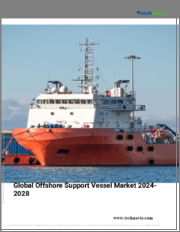
|
시장보고서
상품코드
1408706
해양지원선 시장 : 현황 분석 및 예측(2023-2030년)Offshore Support Vessel Market: Current Analysis and Forecast (2023-2030) |
||||||
해양지원선 시장은 해상풍력 인프라 증가로 인해 예측 기간 동안 CAGR 5% 이상의 강력한 성장을 보일 것으로 예상됩니다. 예를 들어, 2022년 5월 독일, 벨기에, 네덜란드, 덴마크 등 국가들은 2050년까지 북해의 해상 풍력 발전 용량을 150GW 늘릴 계획입니다. 또한 셰브론은 2023년 앵커필드에 원유 7만 5,000배럴, 천연가스 2,800만 입방피트/일 생산능력을 갖춘 시설을 건설해 석유 및 가스 생산량을 늘릴 계획입니다.
유형별로는 앵커 핸들링 태그 공급선, 플랫폼 공급선, 다목적 지원선, 긴급 대응 및 구조선, 승무원 선박, 기타로 구분되며, 2021년에는 앵커 핸들링 태그 공급선이 유리한 시장 점유율을 차지했습니다. 이는 주로 석유 시추 장비의 앵커를 취급하고, 그 위치까지 견인하고, 앵커를 고정하는 등 광범위한 용도로 사용되며, 긴급 대응 및 구조 선박으로도 사용됩니다. 또한, 중장비를 위한 유연한 갑판과 강력한 볼라드 풀로 설계된 추진 시스템을 갖춘 이 인상적인 선박은 거친 바다와 얼음 바다에서의 항해 능력으로 유명합니다. 예를 들어, 콩스버그 마리타임은 2023년 6월 암모니아 연료 엔진과 플러그인 하이브리드 옵션을 갖춘 플랫폼 공급선(PSV)과 앵커 핸들링 태그(AHT)의 차세대 설계를 발표했습니다.
용도별로는 석유 및 가스용과 해상풍력용으로 구분할 수 있습니다. 현재 석유 및 가스 분야가 상당한 시장 점유율을 차지하고 있습니다. 이는 주로 해상 석유 및 가스전에서의 높은 탐사 및 생산 활동이 지속되고 있기 때문입니다. 석유 시추에서 생산에 이르기까지 OSV는 중요한 역할을 담당하고 있습니다. 해양지원선은 해양 석유 및 가스 시추 장비의 운송 솔루션으로 시추 장비 설치 시 작업자를 지원합니다. 또한, 북극해와 같은 심해 활동이 증가함에 따라 OSV에 대한 수요가 증가하고 있습니다. 또한 심해에서 풍력 터빈 프로젝트의 잠재력이 증가하고 있으며, 높은 풍속이 운영에 매우 유리한 환경을 조성하고 있기 때문에 시장을 강력하게 견인할 가능성이 높으며, IEA에 따르면 전 세계 해상 풍력 발전 용량은 2040년까지 15배 증가하여 적절한 정책 시나리오의 채택과 기술 비용 하락으로 1조 달러 규모의 산업이 될 것으로 예측됩니다.
수심에 따라 시장은 얕은 바다와 깊은 바다로 나뉩니다. 현재 주요 유전이 심해에 존재하기 때문에 심해가 시장 점유율이 압도적으로 높습니다. 수년간의 석유 및 가스 수요 증가로 인해 얕은 해역의 탄화수소가 고갈되면서 심해의 탐사 및 생산 활동이 활발하게 이루어지고 있습니다. 또한 석유와 가스 수요 증가에 따라 기업들은 시장 수요와 공급을 유지하기 위해 초심해 탄화수소 탐사에 많은 투자를 하고 있습니다. McKinsey Energy Insights의 Operations and Emissions Benchmarks 보고서에 따르면, 2040년까지 전 세계 에너지 수요는 2,400만 배럴/일 중 심해 분지는 최소 700만 배럴/일에 기여할 것으로 예상됩니다.
해양지원선 산업의 시장 도입에 대한 이해를 돕기 위해 시장은 북미(미국, 캐나다, 기타 북미 지역), 유럽(독일, 영국, 러시아, 프랑스, 스페인, 기타 유럽 지역), 아시아태평양(중국, 일본, 베트남, 호주, 기타 아시아태평양), 기타 세계 각국에서의 세계 존재를 기준으로 분석되었습니다. 현재 북미 지역이 유리한 시장 점유율을 차지하고 있는 것은 이 지역에서 많은 시추, 탐사 및 생산 활동이 이루어지고 있기 때문입니다. 육지와 얕은 바다에 매장량이 성숙함에 따라 대부분의 석유 및 가스 활동은 심해로 이동하고 있습니다. 심해 탐사 및 생산 활동은 미국과 같은 국가에서 증가하고 있으며, OSV의 수도 이 지역에서 선박 제조업체의 증가로 인해 증가하고 있습니다. 또한 DEME Offshore US와 같은 서비스 제공업체가 이 지역에서 운영되고 있으며, Avangrid Renewables와 같은 해상 풍력 발전 사업자가 해상 풍력 터빈을 운송하고 설치하는 데 도움을 주고 있습니다.
목차
제1장 시장 서론
- 시장 정의
- 주요 목표
- 이해관계자
- 제한사항
제2장 조사 방법 또는 가정
- 조사 과정
- 조사 방법
- 응답자 프로파일
제3장 시장 요약
제4장 주요 요약
제5장 COVID-19가 해양지원선 시장에 미치는 영향
제6장 세계의 해양지원선 시장 매출(2020-2030년)
제7장 유형별 시장 인사이트
- 앵커 핸들링 예인 공급선
- 플랫폼 지원선
- 다목적 지원선
- 긴급 대응 및 구조선
- 승무원선
- 기타
제8장 용도별 시장 인사이트
- 석유·가스 용도
- 해상 풍력발전
제9장 수심별 시장 인사이트
- 천해
- 심해
제11장 지역별 시장 인사이트
- 북미
- 미국
- 캐나다
- 기타 북미
- 유럽
- 독일
- 영국
- 프랑스
- 이탈리아
- 스페인
- 기타 유럽
- 아시아태평양
- 중국
- 일본
- 인도
- 기타 아시아태평양
- 세계의 기타 지역
제11장 해양지원선 시장 역학
- 시장 성장 촉진요인
- 시장 과제
- 영향 분석
제12장 해양지원선 시장 기회
제13장 해양지원선 시장 동향과 인사이트
제14장 수요측과 공급측 분석
- 수요측 분석
- 공급측 분석
제15장 밸류체인 분석
제16장 가격 분석
제17장 경쟁 시나리오
- 경쟁 상황
- Porter's Five Forces 분석
제18장 기업 개요
- A.P. Moller-Marsk A/S
- Bourbon Corporation SA
- stensj Rederi AS
- MMA Offshore Limited
- Harvey Gulf International Marine, LLC
- SEACOR Marine Holdings Inc.
- Solstad Offshore ASA
- Tidewater, Inc.
- PACC Offshore Services Holdings Ltd.
- Havila Shipping ASA
제19장 면책사항
ksm 24.01.24Offshore support vessels (OSVs) or Offshore Supply Vessels are specialized vessels for logistical support of different constructions in the offshore platforms and subsea installations. The offshore support vessels market is growing at a fast rate mainly driven by the rise in different offshore oil and gas exploration and offshore wind infrasturture projects. In addition to this, high exploration and development activities in hydrocarbons in ultra deepwater is also driving the demand for OFSV market. For instance, by March 2022, DEME's specialized floating installation vessel Orion had helped with 62 foundation installations including monopile foundations, transition pieces, offshore substation, and scour protection at the 800 MW Vineyard Wind 1 offshore wind farm in the USA. Therefore, rise in different offshore energy exploration and installation projects is propelling the growth of the offshore support vessels market during the forecast period.
The Offshore Support Vessel Market is expected to grow at a strong CAGR of above 5% during the forecast period owing to increasing offshore wind infrastructure. For instance, in May 2022, countries like Germany, Belgium, the Netherlands and Denmark have planned to increase the offshore wind capacity in the North Sea by 150 GW by 2050. Again, Chevron in 2023 has planned to increase its increase oil and gas production by constructing a facility at Anchor Field that is expected to have a capacity of 75,000 barrels of crude oil and 28 million cubic feet of natural gas per day.
Based on type, the market has been segmented as anchor handling tug supply vessels, platform supply vessels, multipurpose support vessels, emergency response & rescue vessels, crew vessels and others. In 2021, anchor-handling tug supply vessels held a lucrative market share. This is mainly due to its extensive use like handling the anchor of an oil rig, tow it to the location and anchor it, and it is also used as an emergency response and rescue boat. Further, they have highly flexible decks for heavy duty equipment and a propulsion system designed with powerful bollard pull, these impressive vessels are known for their seakeeping capabilities in rough or icy waters. For instance, in June 2023, Kongsberg Maritime, launched new generation designs for platform supply vessels (PSVs) and anchor handling tugs (AHTs), equipped with ammonia-fuelled engines as well as plug-in hybrid option with the aim to reducing emissions and increasing onboard energy storage.
By application, the market is segmented into oil and gas applications and offshore wind applications. Currently, oil and gas sector occupy a considerable market share. This is mainly owing to ongoing high exploration and production activities in offshore oil and gas fields. Starting from surveying to production from oil rig OSV's play a critical role. Offshore support vessels act as a transportation solution for offshore oil and gas rigs by assisting operators in transporting rigs equipment at the time of rig installation. Moreover, with increasing activities in deepwater like Artic Ocean demand of OSV's rising due to operations carried require OSV's. Further, the rising scope for relishing the wind turbine projects in deepwater, where the high wind speed creates a much favorable environment for operation is likely to drive to market robustly. According to IEA, global offshore wind capacity is projected to increase fifteen-fold to 2040, becoming a $1 trillion industry with adoption of suitable policies scenario and decreasing technology cost
Based on water depth, the market is bifurcated into shallow water and deepwater. Of both, currently deepwater hold the prominent market share due to major oilfields are present in deepwater. Over the years with increasing oil and gas demands hydrocarbons from shallow waters used up thereby giving boom to explorations and productions activates in deepwater. Moreover, with increasing demand for oil and gas, companies are heavily investing in exploration of hydrocarbons in ultra-deepwater to maintain the demand and supply in the market. In addition, wind turbines are located in deepwater which provides the most suitable environment to work at its full efficiency. According to a McKinsey Energy Insights' Operations and Emissions Benchmarks report, deepwater basins are expected to contribute at least 7 MMbbl/d of the total 24 MMbbl/d global energy needs by 2040.
For a better understanding of the market adoption of the offshore support vessels industry, the market is analyzed based on its worldwide presence in the countries such as North America (United States, Canada, Rest of North America), Europe (Germany, UK, Russia, France, Spain, Rest of Europe), Asia-Pacific (China, Japan, Vietnam, Australia, Rest of Asia-Pacific), Rest of World. Currently, North America holds lucrative market share due to large number of drilling, exploration and production activities in the region. As land and shallow water reserves are matured, most oil & gas activities have shifted to deepwater. Deepwater exploration and production activities have increased in countries like USA. OSVs' count is also growing in the region due to an increase in the number of vessel manufacturers in the market. Moreover, presence of offshore support vessel service providers like DEME Offshore US that are operating in the region, thereby helping offshore wind operators like Avangrid Renewables in transport and installation of offshore wind turbines.
Some of the major players operating in the market include: A.P. Møller - Mærsk A/S; Bourbon Corporation SA; stensj Rederi AS; MMA Offshore Limited; Harvey Gulf International Marine, LLC; SEACOR Marine Holdings Inc.; Solstad Offshore ASA; Tidewater, Inc.; PACC Offshore Services Holdings Ltd.; Havila Shipping ASA.
TABLE OF CONTENTS
1 MARKET INTRODUCTION
- 1.1. Market Definitions
- 1.2. Main Objective
- 1.3. Stakeholders
- 1.4. Limitation
2 RESEARCH METHODOLOGY OR ASSUMPTION
- 2.1. Research Process of the Offshore Support Vessel Market
- 2.2. Research Methodology of the Offshore Support Vessel Market
- 2.4. Respondent Profile
3 MARKET SYNOPSIS
4 EXECUTIVE SUMMARY
5 IMPACT OF COVID-19 ON THE OFFSHORE SUPPORT VESSEL MARKET
6 GLOBAL OFFSHORE SUPPORT VESSEL MARKET REVENUE, 2020-2030F
7 MARKET INSIGHTS BY TYPE
- 7.1. Anchor-handling Tug Supply Vessels
- 7.2. Platform Support Vessels
- 7.3. Multipurpose Support Vessels
- 7.4. Emergency Response and Rescue Vessels
- 7.5. Crew Vessels
- 7.6. Others
8 MARKET INSIGHTS BY APPLICATION
- 8.1. Oil and Gas Applications
- 8.2. Offshore Wind
9 MARKET INSIGHTS BY WATER DEPTH
- 9.1. Shallow Water
- 9.2. Deepwater
11 MARKET INSIGHTS BY REGION
- 10.1 NORTH AMERICA OFFSHORE SUPPORT VESSEL MARKET
- 10.1.1. U.S.
- 10.1.2. Canada
- 10.1.3. Rest of North America
- 10.2 EUROPE OFFSHORE SUPPORT VESSEL MARKET
- 10.2.1. Germany
- 10.2.2. U.K.
- 10.2.3. France
- 10.2.4. Italy
- 10.2.5. Spain
- 10.2.6. Rest of Europe
- 10.3 ASIA PACIFIC OFFSHORE SUPPORT VESSEL MARKET
- 10.3.1. China
- 10.3.2. Japan
- 10.3.3. India
- 10.3.5. Rest of Asia-Pacific
- 10.4 REST OF THE WORLD OFFSHORE SUPPORT VESSEL MARKET
11 OFFSHORE SUPPORT VESSEL MARKET DYNAMICS
- 11.1. Market Drivers
- 11.2. Market Challenges
- 11.3. Impact Analysis
12 OFFSHORE SUPPORT VESSEL MARKET OPPORTUNITIES
13 OFFSHORE SUPPORT VESSEL MARKET TRENDS & INSIGHTS
14 DEMAND AND SUPPLY SIDE ANALYSIS
- 14.1. Demand Side Analysis
- 14.2. Supply Side Analysis
15 VALUE CHAIN ANALYSIS
16 PRICING ANALYSIS
17 COMPETITIVE SCENARIO
- 17.1. Competitive Landscape
- 17.1.1 Porter's Five forces analysis
18 COMPANY PROFILED
- 18.1. A.P. Møller - Mærsk A/S
- 18.2. Bourbon Corporation SA
- 18.3. stensj Rederi AS
- 18.4. MMA Offshore Limited
- 18.5. Harvey Gulf International Marine, LLC
- 18.6. SEACOR Marine Holdings Inc.
- 18.7. Solstad Offshore ASA
- 18.8. Tidewater, Inc.
- 18.9. PACC Offshore Services Holdings Ltd.
- 18.10. Havila Shipping ASA



















